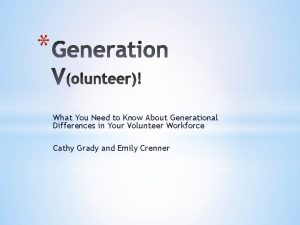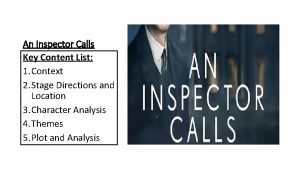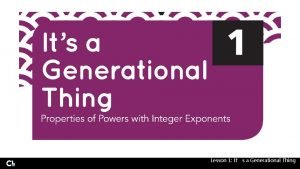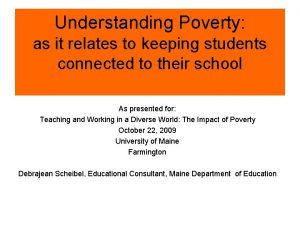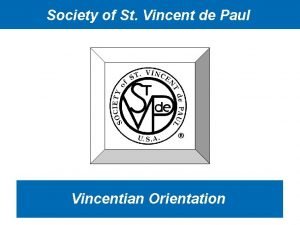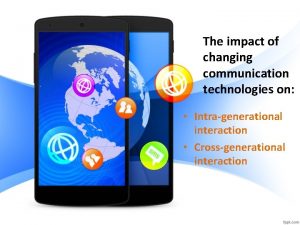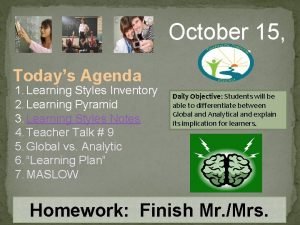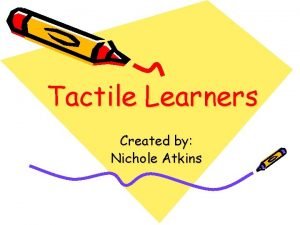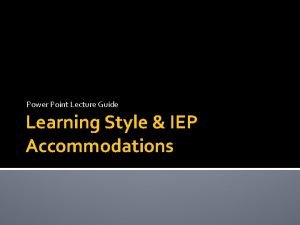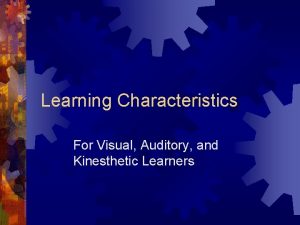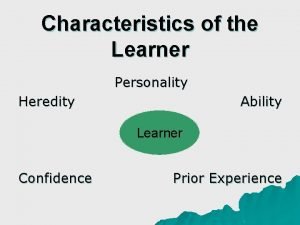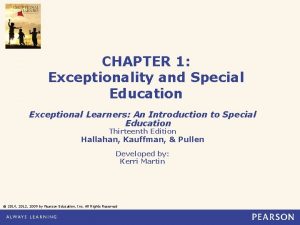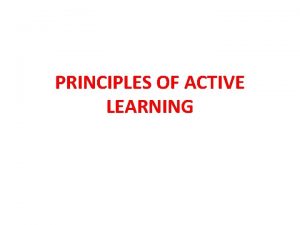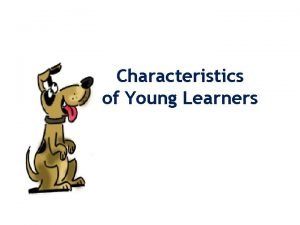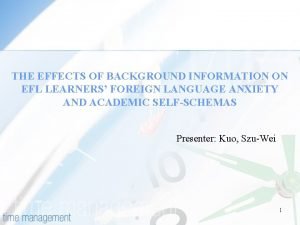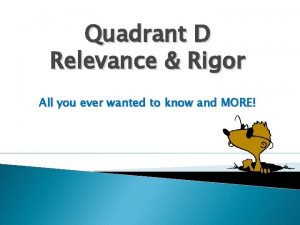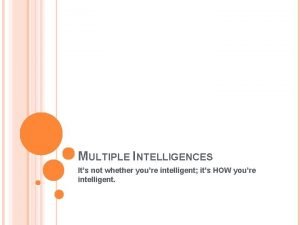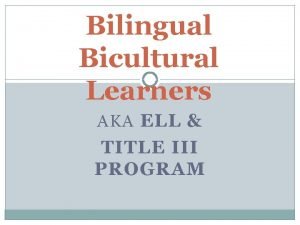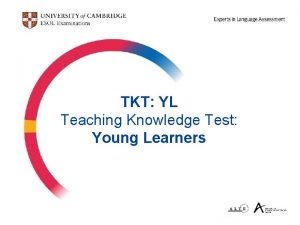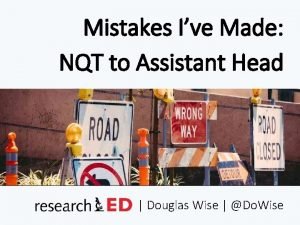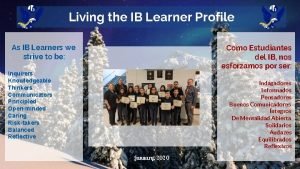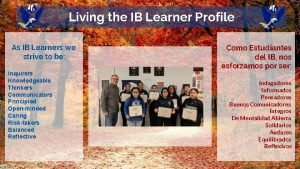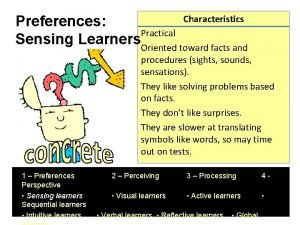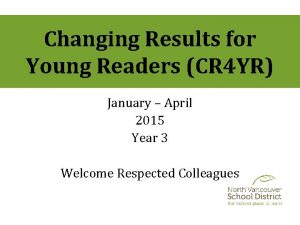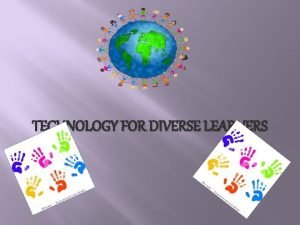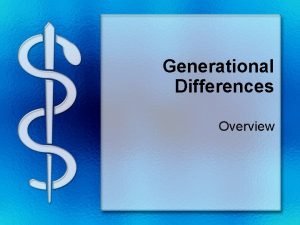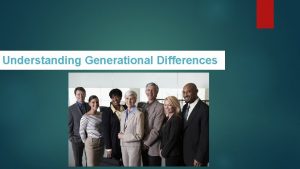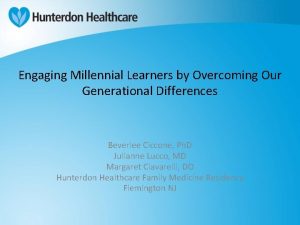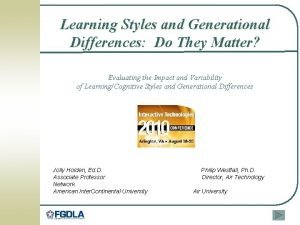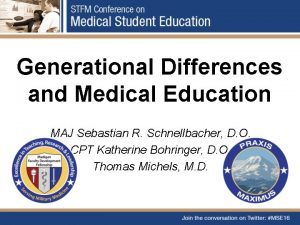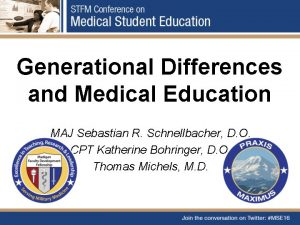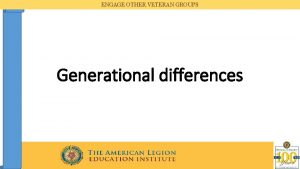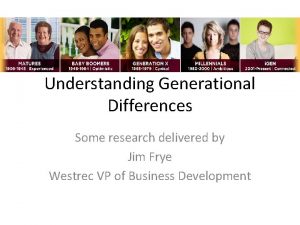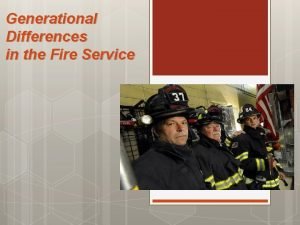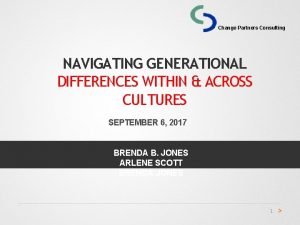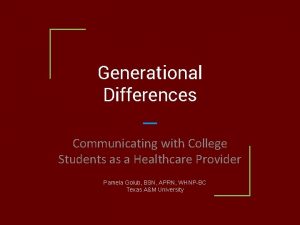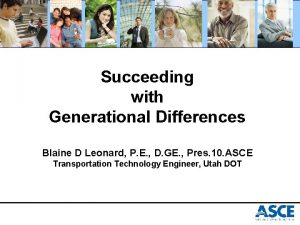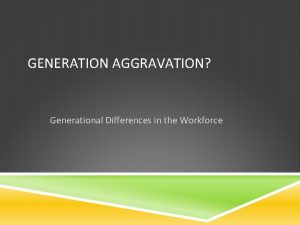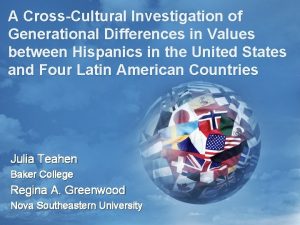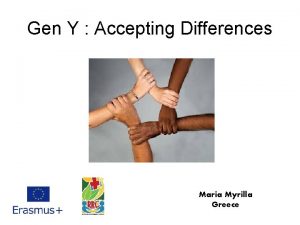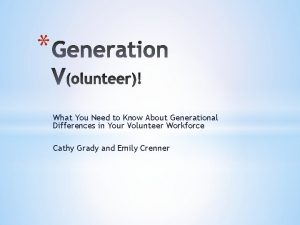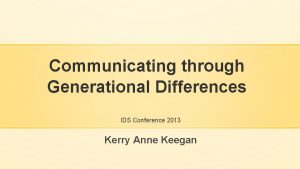GENERATIONAL DIFFERENCES IN LEARNERS AND THE IMPACT ON








































- Slides: 40

GENERATIONAL DIFFERENCES IN LEARNERS AND THE IMPACT ON TEACHING Dorothy Knoll, Ph. D, Dean of Student Services Alice Carrott, MA, Director, Educational Support Services

ASSESSING PRIOR KNOWLEDGE. . . Multiple Turn choice questions on your clickers!

WHAT AGE RANGE DO YOU FALL INTO? A) Older than 63 B) 63 to 45 C) 44 to 32 D) 31 to 19

THERESA IS PART OF WHICH GENERATION? A. Traditionalist Generation B. Baby Boomer Generation C. Gen X D. Millenial Generation

JACK IS MOST LIKELY PART OF WHICH GENERATION? A. Traditionalist Generation B. Baby Boomer Generation C. Gen X D. Millenial Generation

IN ORIENTATION, SARA WOULD MOST LIKELY ENJOY FINDING OUT ABOUT: A. Innovation at the Med Center in a straight forward, factual way. B. How access the various duties of her job on the interactive web site. C. The history, culture, and mission of KUMC. D. Information on how clinical practices have evolved at the med center in order to strategize in the clinical marketplace for future growth.

TO ME, THE RELATIONSHIP BETWEEN TEACHING AND LEARNING IN A PROFESSIONAL SCHOOL IS: A. Primarily the “sage on the stage” in large classes. B. Defined by the number of hours a student puts into learning content. C. A dynamic partnership between teacher and student which evolves over time. D. ready to go once the teacher has his/her lectures up on Angel.

QUESTIONS. . On a piece of paper, please take a minute to write down a couple of questions which you hope will be answered in the next hour.

STUDENTS AT KUMC 1900 -1945 1946 -1964 1965 -1980 1981 -1999 35 156 428 165 250 376 SOM MD 4 138 605 SOM GRD 26 204 152 195 592 1133 SAH SON Total 1 1 = 1921

NUMBER OF PEOPLE IN COHORT Traditionalists (1900 -1945) Baby Boomers (1946 -1964) Generation Xers (1965 -1980) Millennials (1981 -1999) Echo Boom, Gen Y, Baby Bust Now Aged Born before 1946 63 -45 44 -32 31 -19 Number of People in Cohort 75 Million 80 Million 46 Million 76 Million

CAREER GOALS Traditionalists (1900 -1945) Baby Boomers (1946 -1964) Generation Xers (1965 -1980) Millennials (1981 -1999) Echo Boom, Gen Y, Baby Bust Now Aged Born before 1946 63 -45 44 -32 31 -19 Career Goals Build a Legacy Build a Stellar Career Build a Portable Career Build Parallel Careers

WHAT BALANCE MEANS TO GENERATIONS Traditionalists (1900 -1945) Baby Boomers (1946 -1964) Generation Xers (1965 -1980) Millennials (1981 -1999) Echo Boom, Gen Y, Baby Bust Now Aged Born before 1946 63 -45 44 -32 31 -19 What Balance means to the Generations Support me in shifting the balance. Help me balance everyone else and find meaning myself Give me balance now, now when I’m sixty-five Work isn’t everything; I need flexibility so I can balance all my activities

ORIENTATION PROGRAMS Traditionalists (1900 -1945) Baby Boomers (1946 -1964) Generation Xers (1965 -1980) Millennials (1981 -1999) Echo Boom, Gen Y, Baby Bust Now Aged Born before 1946 63 -45 44 -32 31 -19 Orientation Programs History, Culture, & mission of organization Where their future is with the company Prove that they made the correct decision to take position Includes technology, questions/ answers

FEEDBACK BY GENERATION Traditionalists (1900 -1945) Baby Boomers (1946 -1964) Generation Xers (1965 -1980) Millennials (1981 -1999) Echo Boom, Gen Y, Baby Bust Now Aged Born before 1946 63 -45 44 -32 31 -19 Feedback by Generation No news is good news Feedback once a year, with lots of documentation Sorry to interrupt, but how am I doing? Feedback whenever I want it at the push of a button.

TRAINING THE GENERATIONS Traditionalists (1900 -1945) Baby Boomers (1946 -1964) Generation Xers (1965 -1980) Millennials (1981 -1999) Echo Boom, Gen Y, Baby Bust Now Aged Born before 1946 63 -45 44 -32 31 -19 Training the Generations I learned it the hard way; you can, too! Train ‘em too much and they’ll leave. The more they learn, the more they stay Continuous learning is a way of life.

STUDENTS AT KUMC 1900 -1945 1946 -1964 1965 -1980 1981 -1999 35 156 428 165 250 376 SOM MD 4 138 605 SOM GRD 26 204 152 195 592 1133 SAH SON Total 1 1 = 1921

TECHNOLOGY SAVVY The net powered generation has internalized the internet and uses it instinctively.

GOAL ORIENTATED Millennials are ambitious in their career aspirations yet frequently have unrealistic expectations about what it takes to achieve these goals.

MULTI-TASKER Shortened attention span. Lack of introspective ability.

CONNECTION TO OTHERS Millennials feel more of an urge to homogenize, to celebrate ties that bind rather than differences that splinter.

TEAM ORIENTATED Less individualistic and more inclined to value “team over self, duties over rights, honor over feeling, action over words. ”

EXPECT DIVERSITY The more tolerant attitudes of younger generations will result in an insistence that a company’s products, services and staff reflect the diversity of their world.

TEACHING AND LEARNING It’s a partnership between teacher and learner. Both have certain duties in that partnership. The generational membership will color that partnership, but not define it. Both must commit to learning goals.

RESPONSIBILITIES OF THE TEACHER. . . Competent content expert Meet the learner where they are Be willing to model how you think about the content Engage in and promote active learning

TEACHER AS CONTENT EXPERT This is the obvious expectation. As the expert, you have developed your mental model of how you think about the content. Must be able to translate your knowledge into the goal or job.

MEET THE STUDENT WHERE THEY ARE. . . Pryor knowledge of content. What is their learning style? What is the learner’s history? How do the generational characteristics color this?

MODEL HOW TO THINK ABOUT THE CONTENT You have made the transition from a student of health sciences to a professional in health sciences. You know the job description or desired outcome. You know the rigor involved to get there. You know the important scaffolding. You know the necessary connections to make.

ENGAGE AND PROMOTE ACTIVE LEARNING Active Learning promotes: Ø long term memory. Ø the connections between the content areas and the clinical experience. Ø asking questions which in turn fuels critical thinking.

RESPONSIBILITIES OF THE LEARNER Be a partner in the learning process. Know your learning style: http: //www. engr. ncsu. edu/learningstyles/ilsweb. html o Be open to developing and trying new strategies and skills to help you form your mental model. o Engage in active learning for long term memory

WHAT HAPPENS WHEN THE PARTNERSHIP GOES AMUCK AND DISCONNECTS? How to use active learning and generational preferences to your best advantage to get things back on track? Focus on the learning and shared goals. Flex to make it for you.

USING TECHNOLOGY TO YOUR ADVANTAGE The Millennials know how to use it! Important to remember to start w/ content to be mastered, then figure out how technology can best be used to enable the mastery. Downsides?

KEEPING THE CAREER GOAL AT THE CENTER OF LEARNING As teachers/ healthcare providers, you know the job description they are preparing for – mold their thinking for best practices and gold standard of care. Feedback: Deliberate, specific and timely. Coaching for reaching the goal – be realistic! Takes practice of skills. Patience. No instant gratification.

MULTI TASKING Is this an asset or a liability? ? Time management is the heart of multitasking. Where does prioritization come in? With shortened attention span, comes lack of introspective ability

CONNECTIONS TO OTHERS AT KUMC On the Net and Cyber Space Volunteerism Experiential learning Preceptors/ Practicums Clinical skills labs PBL’s and Seminars

TEAM ORIENTED Have grown up in the team culture. The norm now in health careers. Must be deliberate training for positive outcomes.

Clickers back on!

WHICH CHARACTERISTIC IS LEAST LIKELY TO BE A DESCRIPTOR OF A MILLENNIAL STUDENT? A. Team oriented B. Close to their parents C. Entrepreneurial impulses D. Wired E. Expect diversity

A WAY I CAN INCORPORATE NEW TECHNIQUES TO REACH MY LEARNERS WOULD BE: A. Help them to find out what learning style they primarily use. B. Incorporate learning opportunities using various forms of technology. C. Incorporate more active learning opportunities in my presentation of content material. D. Develop a protocol which would help me give more specific and deliberate feedback to my learners. E. Work on areas to link team work learning to career goals.

REFERENCES Borges, Nicole J. , et al (2006). Comparing Millennial and Generation X Medical Students at One Medical School. Academic Medicine. Northeastern Ohio Universities College of Medicine. Elam, C. , & Borges, N. (2002). Millennials in Medicine: A New Generation Comes to Medical School. (pp. 1 -24). University of Kentucky College of Medicine. Hagans, C. (2005). Understanding our Multigenerational Interactions. NPC Housing Forum (pp. 1 -43). Butler University. Hundrieser, D. J. (2008). Learning Theory and Millennials: Competencies and Accountability. , The Millenial Generation (pp. 219231). Florida. Johnson, Susan A. & Romanello, Mary L. (2005) Generational Diversity: Teaching and Learning Approaches. Nurse Educator (pp. 212 -216). College of Mount St. Joseph, Cincinnati, Ohio.

REFERENCES Lancaster, L. C. , & Stillman, D. (2002). When Generations Collide: Who They Are. Why They Clash. How to Solve the Generational Puzzle at Work. New York: Harper. Collins Publishers Inc. Larson, J. (2008, May). Exploring the Generation Gap in the Nursing Workforce. Retrieved March 2009, from Nurse. Zone. com: www. nursezone. com Mc. Leod, P. A. Generational Differences: Implications for Teachers and Learners. (pp. 1 -40) Pensacola: Florida State University. Piper, L. E. (2008). The Generation-Y Workforce in Health Care, The New Challenge for Leadership. The Health Care Manager, (pp. 98103). Riddle, Janet (2009). Social Networking: What are the Ramifications for Medical Education? Discussion at AAMC CGEA conference, March 26 -28, Mayo Clinic. Skiba, Diane J. & Barton, Amy J. (2009) Adapting your Teaching to Accommodate the Net Generation of Learners. The Online Journal of Issues in Nursing.
 Generational differences chart
Generational differences chart Communicating across generational differences
Communicating across generational differences Sheila birling
Sheila birling Lesson 1 it's a generational thing m5-23 answers
Lesson 1 it's a generational thing m5-23 answers Generational poverty
Generational poverty St vinny
St vinny Intra-generational interaction
Intra-generational interaction Prc br435 – code of ethics for professional teachers
Prc br435 – code of ethics for professional teachers The gifted philippines
The gifted philippines Active and passive learners
Active and passive learners Global vs analytical learners
Global vs analytical learners Teaching grammar to young learners
Teaching grammar to young learners Facts about tactile learners
Facts about tactile learners Remedial teaching is
Remedial teaching is Global vs analytical learners
Global vs analytical learners Auditory learner characteristics
Auditory learner characteristics Eager learner vs lazy learner
Eager learner vs lazy learner Learn to learn
Learn to learn When is cognitivism beneficial for learners
When is cognitivism beneficial for learners Domain 3 diversity of learners examples
Domain 3 diversity of learners examples Inheritance characteristics
Inheritance characteristics Exceptional learners: an introduction to special education
Exceptional learners: an introduction to special education Assistive technology for english language learners
Assistive technology for english language learners Principles of active learning
Principles of active learning Young learners characteristics
Young learners characteristics Questioning and discussion techniques
Questioning and discussion techniques Background information for learners
Background information for learners Rigor relevance quadrants
Rigor relevance quadrants Spatial intelligence famous person
Spatial intelligence famous person The learners will be able to
The learners will be able to English language learners
English language learners Tkt young learners book
Tkt young learners book Teaching young learners english
Teaching young learners english Reading strategies for english language learners
Reading strategies for english language learners Graham nuttall the hidden lives of learners
Graham nuttall the hidden lives of learners Ib learner profile inquirer
Ib learner profile inquirer Ib learners profile
Ib learners profile Cr part 154
Cr part 154 Sensing learners characteristics
Sensing learners characteristics Changing results for young learners
Changing results for young learners Technology for diverse learners
Technology for diverse learners
